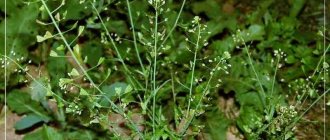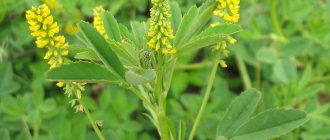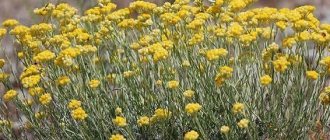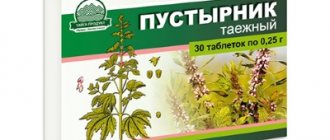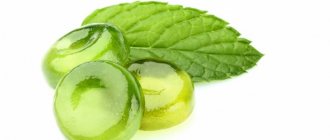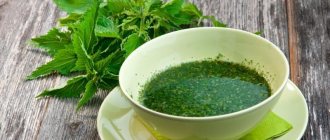The plant cuff, the medicinal properties and contraindications of which have been known since time immemorial, was known in Rus' under different names. It was called forest horseradish and sundew, God's tear, ram (due to the special predilection of livestock) and creep. The Latin name of the rosette is Alchemílla, it belongs to the rose family, it is a herbaceous plant with a straight rhizome that grows for several years. Cuff grass is widespread. E can be equally easily found in Eurasia, Greenland, and North America. Recently, it has begun to be grown on private land plots to obtain medicinal raw materials and be used for medicinal purposes.
Description of the cuff
Content
Common mantle is a perennial herbaceous plant with an erect rhizome and the same leaves, on which venation is clearly visible. The maximum height to which the creeper grows is 40 cm, although when grown at home and creating a favorable climate for growth, it can reach 50-60 cm. In appearance, it is quite easy to distinguish it from other herbaceous plants, mainly by the inflorescence, located in the receptacle calyx. It was this characteristic feature that became the reason for the plant’s most famous name.
It evokes associations with a long ripped cuff from which a hand peeks out. The number of flowers in an inflorescence may vary, depending on the age and growing conditions, but in a good season the plant can bloom twice - in spring and autumn. The cuff plant produces a lot of small seeds, but their use for industrial purposes requires a long waiting period for the product, so in dachas and gardens it is planted using division. You can avoid waiting for the plant's second year if you plant its seeds in seedling boxes, as is done with other garden perennials.
To produce fruits that resemble a small nut, the sundew does not necessarily require fertilization; the mantle still goes through the process of forming the fruit, because this assumes its natural structure. The plant has been used in alternative medicine for centuries, and the reason for this is the rich natural composition that it accumulates in its segments.
Compound
Knowing what a cuff looks like, they try to stock it up for future use in order to use it for medicinal purposes if necessary. The scope of application of the herb extends to many needs of the human body, from gynecological to metabolic disorders. It treats tuberculosis and dysbacteriosis, restores the female reproductive cycle, and relieves swelling and congestion in the respiratory organs. All these natural properties can be used thanks to the healing composition, in which clinical studies revealed:
- tannins, which make it possible to widely use the plant for skin lesions, diarrhea, tuberculosis and lung lesions, as well as for cosmetic purposes - to eliminate acne, rashes associated with metabolic or hormonal disorders;
- catechins and flavonoids, today – herbal remedies widely used in pharmacology to obtain an antiplatelet effect, optimize the state of venous and capillary networks in the body;
- phenolcarboxylic acids, in particular, necessary for some vital processes, phenolcarbon derivatives luteonic and ellagic, which are rarely found in nature, but may be important in disease states;
- lignin is a substance that determines the state of some cells (not only the herb is sold in pharmacies, but also lignin separately, as a medicine known for its ability to bind toxins and harmful substances in severe poisoning;
- lipids and coumarins, useful for anemia and general weakening of the body.
Listing what the cuff treats could take several pages, since due to its healing composition it can be useful for many conditions. The chemical components of the creeper have not been sufficiently studied. However, the benefits that treatment with a medicinal perennial plant can bring have been known for many centuries, and the modest-looking herb has been used since ancient civilizations.
Long sold as a pharmaceutical product prepared from industrially grown raw materials, it is especially widespread in Western European countries and in many Eastern and Southern countries. In the Russian Federation, the cuff has always been used for medicinal purposes by representatives of alternative medicine, but now it has become a widely used medical product. Preparations and raw materials from medicinal plants can always be purchased at retail pharmacy chains.
Don’t be shy, ask our consultants questions, right here on the website. We will definitely answer. Leave commentsGo
Cuff: medicinal properties
The leaves of the plant contain not only the above components, which make it possible for specific use, but also useful microelements that are not common enough in nature (zinc, boron, manganese), a large amount of ascorbic acid (which explains its useful properties for general regenerative therapy), lecithin, steroids and tannin. Although the pink mantle is not included in the number of pharmacopoeial plants in Russia, there is no doubt that this is not far off. This is proven even by the industrial cultivation of forest horseradish and its demand in various branches of medicine.
The cuff has a wide range of medicinal properties, which makes it possible to use it as:
- an anti-inflammatory agent with a wound-healing effect, not only for external but also internal lesions (pathologies of the lungs and bronchi, tuberculosis, diseases of the kidneys and gallbladder, liver and hepatic ducts;
- an astringent and expectorant that gives an excellent effect against colds and upper respiratory tract infections;
- it is used for medicinal purposes and for systemic diseases - osteochondrosis, diabetes mellitus, diseases of the hematopoietic system;
- metabolic disorders, diseases of the digestive system, atherosclerosis and dyspepsia, peristalsis disorders and indigestion - successful treatment with an aqueous infusion of the herb with its rich content of natural components;
- the ability of the cuff to regulate blood circulation is used in the treatment of cardiovascular diseases, gynecology, stopping internal (including uterine) bleeding, and hemorrhoids.
In folk medicine, the cuff is used in different forms, the most common being a water infusion and decoction, but it can also be used as an external remedy for acne, in the treatment of hemorrhoids, and skin lesions. Mantle leaves are not the only type of medicinal raw material; when collected, the entire above-ground part (shoots, leaves and flowers) is cut off, although the fruits and rhizomes are also used in specific recipes.
Using the cuff in cooking
Young leaves and shoots of cuffs are used in salads (for example, in combination with nettle leaves), soups (cabbage soup is prepared with cuffs). In dried, crushed form, the mantle can be used as a seasoning for the main dish.
DO NOT use on the cuff
Old plants should not be eaten: the taste of the cuff is, in principle, slightly bitter and tart, and in older plants the bitterness becomes even more pronounced. You should not add plants grown in the sun to dishes: their leaves and flowers also have a not very pleasant bitter-astringent taste.
mantle is used in cooking. Mantle inflorescences are also often eaten. In crushed form, they are added to a variety of pastes and sandwich spreads.
Grass cuff: application
The use of perennial herbs in alternative medicine is popular. Traditional healers use its natural remedies as a treatment for the digestive system and problems with the cardiovascular system, and are used for anemia and ulcers of the stomach and duodenum. The lignin contained in it makes it possible to recommend medicinal decoctions as a powerful detoxification agent, and bioflavonoids as a natural plant antioxidant and antiplatelet agent. The Central Botanical Garden, a branch of the Russian Academy of Sciences in Siberia, received patents from the Laboratory of Phytochemistry for the use of cuff preparations in the treatment of vascular pathologies. In this case, its restorative, regenerative, antioxidant and wound-healing properties are involved.
Cuff in gynecology
In gynecology, the range of uses of horseradish is unusually wide. It is used to treat pathologies of the mammary gland, endometriosis and dysmenorrhea, and is prescribed for excessive leucorrhoea and uterine bleeding. The cuff plant exhibits medicinal properties in gynecology for any disorders of the menstrual cycle, hypermenstrual syndrome, neoplasms and hemorrhoids. Much of the gynecological use is due to the herb's ability to regulate endocrine disorders. After all, they are, most often, the cause of dysfunction of the female reproductive system during the reproductive, pubertal and menopausal periods.
Cuff: diabetes mellitus
The main effect in diabetes is the restoration and normalization of hormonal levels, the disruption of which leads to the development of pathology. In a diabetic, the cuff optimizes the state of the vascular system, regulates metabolism, and prevents the development of atherosclerosis, which is a common consequence. The action of sundew also allows you to eliminate swelling, which is characteristic of many stages of the development of the disease.
Cuff during pregnancy
During pregnancy, sundew can prevent the threat of miscarriage, but this is not all of its beneficial properties. Used in the correct proportions, it stimulates the development of the fetus and prevents deviations, helps to cope with the manifestations of disorders of nervous activity (depression, irritability, aggressiveness) and prepares the body for the upcoming birth. After childbirth, medicinal herb will help stop heavy bleeding.
Weight loss
In losing weight, the main role is played by phenolcarboxylic acid, which is indispensable in normalizing vascular and metabolic activity. The cuff is also used to shed excess accumulations because of flavonoids - they help maintain cell tone and normalize the condition of the skin after weight loss.
Rule 2: sleep at least 10 hours a day
In the third trimester of gestation, proper rest is very important. Sufficient sleep is the key to your good health, excellent mood, and normal fetal development.
The duration of sleep should be such that after waking up you feel rested and alert. And if for non-pregnant women it is enough to sleep 7-8 hours, then expectant mothers need to rest more - at least 10 hours a day.
It is especially important to get good sleep before giving birth. Imagine a situation where you didn’t sleep at night, and in the morning contractions started, and you went to the maternity hospital. Will your insomnia affect the birth process? It will definitely have an impact.
Insomnia during pregnancy is a reason to consult a psychologist . Perhaps your insomnia is due to fear of the upcoming birth or fear for the health of the unborn baby? A specialist will help you figure out what is happening to you.
Conventional cuff: contraindications
There are only two contraindications for this valuable herbal medicinal component - if a person has increased blood clotting, consuming decoctions can lead to undesirable consequences. Therefore, before consuming it is necessary to consult a doctor and take a blood test. The second point that must be taken into account is the possibility of allergic reactions. But it is present whenever natural animal and plant components are used in treatment. A consultation with a doctor can always help you decide on the advisability of use, who will take into account all the existing risks from using natural treasure.
Rule 6: don’t forget to prepare for the upcoming birth
In the third trimester of pregnancy, it is imperative to prepare for childbirth. Of course, it is better to do this in advance. But even if you only have a few weeks or days left before giving birth, be sure to try to get as much useful information as possible.
Important questions that a pregnant woman should know the answers to:
- How are contractions different from the precursors of labor?
- What to do if your water breaks?
- When should you go to the maternity hospital?
- What happens during the first, second and third stages of labor?
- How long does the birth process last?
This information will help you overcome the fear of childbirth and successfully cope with such a difficult task as the birth of a baby.
Cuff recipes
For preventive purposes and as a treatment, decoction and tea from mantle are used. It is often included in herbal preparations, but here you need to know exactly for what purpose and in what dosage the creeper is used. For prevention and treatment, you can use independently collected raw materials, or purchased at a pharmacy.
Decoction
- Place 4 tsp per quarter liter of water. prepared raw materials, which are boiled for 5 minutes over low heat. It is recommended to take 50 ml per day until improvement. The same product can be used for cosmetic and medicinal purposes, as a compress.
Tea and extract
Cuff tea is even easier to prepare - 2 tsp. pour boiling water over the pot and let it brew. It not only tones the body and relieves insomnia, but also has a general strengthening effect. Mantle extract can be purchased at an herbalist or retail pharmacy to save the hassle of preparing the herb.
The mantle plant, the medicinal properties and contraindications of which are known to many developed civilizations, has long been known as a real panacea for many conditions. Instead of taking synthetic drugs with side effects, you can use natural treasures of health as treatment.


